PHYSICALLY BASED ILLUMINATION
|
|
In order to get a more realistic representation of lighting, we need to move away from the simplistic models that are found hard coded in most graphics pipelines and move to something that is based more in a physical representation of light as a wave with properties of its own that can interact with its environment. To do this, we'll need to understand how light passes through a medium and how hitting the boundary layer at the intersection of two media can affect light's properties. In Figure 3.22, there's an incident light hitting a surface. At the boundary of the two media (in this case, air and glass), there are two resulting rays of light. The reflected ray is the one that we've already discussed to some extent, and the other ray is the refracted or transmitted ray.
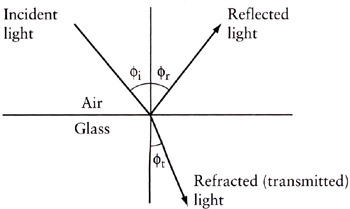
Figure 3.22: Light being reflected and refracted through a boundary.
In addition to examining the interaction of light with the surface boundary, we need a better description of real surface geometries. Until now, we've been treating our surfaces as perfectly smooth and uniform. Unfortunately, this prevents us from getting some interesting effects. We'll go over trying to model a real surface later, but first let's look at the physics of light interacting at a material boundary.
Reflection
Reflection of a light wave is the change in direction of the light ray when it bounces off the boundary between two media. The reflected light wave turns out to be a simple case since light is reflected at the same angle as the incident wave (when the surface is smooth and uniform, as we'll assume for now). Thus for a light wave reflecting off a perfectly smooth surface
![]()
Until now, we've treated all of our specular lighting calculations as essentially reflection off a perfect surface, a surface that doesn't interact with the light in any manner other than reflecting light in proportion to the color of the surface itself. Using a lighting model based upon the Blinn—Phong model means that we'll always get a uniform specular highlight based upon the color of the reflecting light and material, which means that all reflections based on this model will be reminiscent of plastic. In order to get a more interesting and realistic lighting model, we need to add in some nonlinear elements to our calculations. First, let's examine what occurs when light is reflected off a surface. For a perfect reflecting surface, the angle of the incoming light (the angle of incidence) is equal to that of the reflected light. Phong's equation just blurs out the highlight a bit in a symmetrical fashion. Until we start dealing with nonuniform smooth surfaces in a manner a bit more realistic than Phong's in the section on surface geometry, this will have to do.
Refraction
Refraction happens when a light wave goes from one medium into another. Because of the difference in the speed of light of the media, light bends when it crosses the boundary. Snell's law gives the change in angles.
![]()
where the n's are the material's index of refraction. Snell's law states that when light refracts through a surface, the refracted angle is shifted by a function of the ratio of the two material's indices of refraction. The index of refraction of vacuum is 1, and all other material's indices of refraction are greater than 1.
What this means is that in order to realistically model refraction, we need to know the indices of refraction of the two materials that the light is traveling through. Let's look at an example (Figure 3.23) to see what this really means. Let's take a simple case of a ray of light traveling through the air (nair ≅ 1) and intersecting a glass surface (nglass ≅ 1.5). If the light ray hits the glass surface at 45°, at what angle does the refracted ray leave the interface?
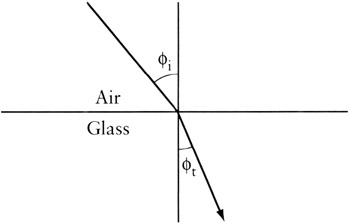
Figure 3.23: The refracted ray's angle is less than the incoming ray's.
The angle of incidence is the angle between the incoming vector and the surface. Rearranging Snell's law, we can solve for the refracted angle.
![]()
Inserting the values give us

which is a fairly significant change in the angle! If we change things around so that we are following a light ray emerging from water into the air, we can run into another phenomenon. Since the index of refraction is just a measure of the change in speed that light travels in a material, we can observe from Snell's law (and the fact that the index of refraction in a vacuum is 1) that light bends toward the normal when it slows down (i.e., when the material it's intersecting with has a higher index of refraction). Consequently, when we intersect a medium that has a lower index of refraction (e.g., going from glass to air), then the angle will increase. Ah, you must be thinking, we're approaching a singularity here since we can then easily generate numbers that we can't take the inverse sine of! If we use Snell's law for light going from water to air, and plug in 90° for the refracted angle, we get 41.8° for the incident angle. This is called the critical angle at which we observe the phenomenon of total internal reflection. At any angle greater than this, light will not pass though a boundary but will be reflected internally.
One place that you get interesting visual properties is in the diamond—air interface. The refractive index of a diamond is fairly high, 2.24, which means that it's got a very low critical angle, just 24.4°. This means that a good portion of the light entering a diamond will bounce around the inside of the diamond hitting a number of air—diamond boundaries, and as long as the angle is 24.4° or greater, it will keep reflecting internally. This is why diamonds are cut to be relatively flatish on the top but with many faceted sides, so that light entering in one spot will bounce around and exit at another, giving rise to the sparkle normally associated with diamonds.
Another place where a small change in the indices of refraction occurs is on a road heated by the sun when viewed from far away (hence a glancing incident angle). The hot air at the road's surface has a slightly smaller index of refraction than the denser, cooler air above it. This is why you get the effect of a road looking as though it were covered with water and reflecting the image above it—the light waves are actually reflected off the warm air—cold air interface.
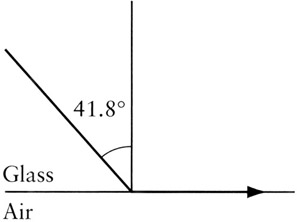
Figure 3.24: The critical angle.
What makes this really challenging to model is that the index of refraction for most materials is a function of the wavelength of the light. This means that not only is there a shift in the angle of refraction, but that the shift is different for differing wavelengths of light. Figure 3.25 and 3.26 show the index of refraction for fused quartz and sapphire plotted against the wavelength. You can see the general trend that shorter wavelength light (bluish) tends to bend more than the longer (reddish) wavelengths.
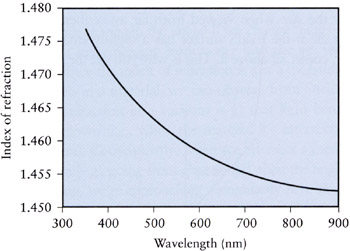
Figure 3.25: Index of refraction as a function of wavelength for quartz.
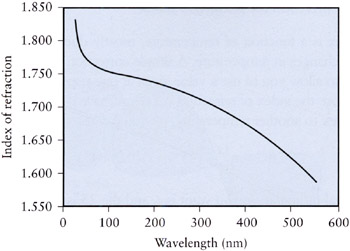
Figure 3.26: Index of refraction as a function of wavelength for sapphire.
This is the phenomenon that's responsible for the spectrum that can be seen when white light is passed through a prism (Figure 3.27). It's refraction that will break apart a light source into its component colors, not reflection.
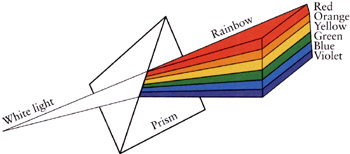
Figure 3.27: The wavelength dependence of the index of refraction in action.
This is one area where our simplistic model of light breaks down since we're not computing an entire spectrum of light waves, but we're limited to three primary colors. For reference, the rgb values can be assigned to a range of wavelengths as follows:

There's a lot more to color science than just determining wavelengths, but that's beyond the scope of this book.
While the spectrum spreading effect of refraction is interesting in itself, the rgb nature of computer color representation precludes performing this spreading directly—we can't break up a color value into multiple color values. However, with some work, you can compute the shade of the color for a particular angle of refraction and then use that as the material color to influence the refracted color.
Temperature Correction for Refractive Index
Refractive index is a function of temperature, mostly due to density changes in materials with changes in temperature. A simple correction can be applied in most circumstances to allow you to use a value given at one temperature at another. For example, suppose the index of refraction value you have is given at 25°C: η25. To convert the index to another temperature, ηt, you can use the following equation:
![]()
where the actual temperature you want is t, and the 25 is the temperature (both in °C) of the actual index you have, η25.
The Fresnel Equations
The Fresnel (pronounced Freh-nel) equations are used to calculate the percentage of energy in the refracted and the reflected parts of the wave (ignoring adsorption). In order to understand what the equations calculate, we'll have to take a look at what happened when a light wave (as opposed to a photon) interacts with a surface. We have to do it this way since this is the only way to describe the subtle (and realistic) visual effects we are looking for. A wave of energy has both an electric field and a magnetic field that travel in perpendicular phase, as shown in Figure 3.28.

Figure 3.28: The perpendicular nature of the magnetic and electrical fields of a light wave.
In general, when a wave reaches a boundary between two different dielectric constants, part of the wave is reflected and part is transmitted, with the sum of the energies in these two waves equal to that of the original wave.
The Fresnel equations are a solution to Maxwell's equations for electromagnetic waves at the interface. If you are really interested in seeing how this works see [HECHT 1987], but I'll spare you the actual derivation and get to the important part. What Fresnel did (besides proving once and for all that light can behave like a wave) is figure out that for the two extrema of the light wave—the light wave with the electric field parallel to the surface and the light wave with the electric field perpendicular to the surface, the energy transmitted and reflected—are functions of the angle of incidence and the indices of refraction for the two media. This is for a nonconductive (dielectric) medium like plastic or glass.
For a conductive media, there's actually some interaction between the free electrons in the conductor (or else it wouldn't be a conductor) and the magnetic field of the light wave. Being a conductor, there are free electrons in the material. When the light wave interacts with the material, the electrons in the material oscillate with the magnetic field of the light wave, matching its frequency. These oscillations radiate (and, in effect, reflect) the light wave. In addition, a conductor has some resistance to electron movement, so the material absorbs some of the energy that would have been reradiated. Fresnel equations for conductive interfaces (since they absorb light they are also generally opaque) usually involve a dielectric (like air) and a conductor since you don't have a light interface between two opaque materials. The parallel and perpendicular components are sometimes referred to as the p-polarized and s-polarized components, respectively.
Fresnel Equations for Dielectrics
The simplest form of the Fresnel equations are for dielectrics.
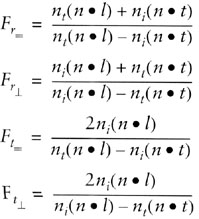
where r and t are broken into parallel and perpendicular segments. nt and ni are the indices of refraction for the transmitting (reflecting) and incident materials respectively.
Now we can simplify these equations by assuming normalized vectors and multiplying out the dot products, noting that n • 1 = cos(φi) and n • t = −cos(φi), and using Snell's law to get rid of the indices of refraction. φi is the angle of incidence and φt the reflected angle. These simplified equations are

Using these equations, we can calculate the percent of energy transmitted or reflected. Since these equations represent the maxima and minima of the interaction between the media depending upon the orientation (polarization) of the light wave's fields, we'll just take the average to compute the amount transmitted and reflected. Thus

gives us the fraction of unpolarized light transmitted and reflected. Note that this average is for unpolarized light. If your light source was polarized, you could pick one equation instead of the average. Also note that due to the conservation of energy, we could also write
![]()
In 1818, the French Academy of Science held a competition for best essay covering the wave theory of light. At this time, there was great debate about whether light was a particle or a wave. A 30–year-old civil engineer by the name of Augustin Fresnel submitted a monster 135–page paper on the theory of light waves and their diffraction for the competition, which completely went against the particle theory since particles don't bend. Though an excellent theorist, Fresnel couldn't solve some of his equations in his paper. Unfortunately for him, one of the judges of the competition was an excellent mathematician: Siméon Denis Poisson. Poisson also happened to be a very strong believer in Newton's particle theory of light and was able to solve Fresnel's equations. He then set out to "prove" that the wave theory was wrong using Fresnel's own equations. Poisson stated that Fresnel's equations gave the absurd prediction that a disk casting a shadow would show a bright spot at the center of the shadow due to the diffraction waves all being in phase. The waves would all contribute to make the spot just as bright as if the disk weren't there. A simple experiment would prove it so. Another judge of the competition, Fran¸ois Arago, arranged to have the experiment performed, and the bright spot was seen! Fresnel was awarded the prize in 1819, and Poisson greatly, though unintentionally, advanced the wave theory of light. The bright spot is usually referred to as Poisson's bright spot, though Poisson refused to believe in the wave theory up to his death 30 years later. You can perform this experiment yourself—it works best with laser light. The spot shows up a little over a disk's width behind the disk. You can also see it during a solar eclipse as a bright ring around the moon's disk. Figure 3.29 shows the bright spot and the other waves of interference.
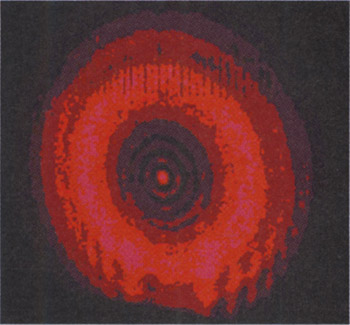
Figure 3.29: Poisson's bright spot.
Let's take a look at what this means in a practical application. Let's plot the values for the Fresnel equation for the air-glass interface (Figure 3.30). The first thing you should notice is that even when the incident angle is at 0°—that is, the light is shining along the surface normal—there is still some loss in transmittance.

Figure 3.30: The reflection and transmission curves for the parallel and perpendicular waves in the air-glass interface.
If we do the math, we will discover that there is no distinction between the parallel and perpendicular components when the angle is 0°, and in this case, the Fresnel equations simplify to the following:
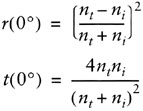
Thus at 0° for the air-glass interface, we can see that about 4% of the light is reflected. This means that if you have a glass window, you will get only 92% of the light transmitted through (you have the air-glass interface, 4% reflected, and the glass-air interface, another 4%, when the ray comes out of the glass). Glass used in optics is usually coated with a thin film of antireflective coating, which reduces the reflectivity to something around 1%. You might also note that at an angle of about 56°, the parallel reflectance drops to zero. This is called Brewster's angle or the polarization angle (φp) and is the effect on which polarized lenses work. You can use Snell's law and the observation that for polarized light φt = 90° − φp to derive the following equation for Brewster's angle:
![]()
Let's plot the average reflected and transmitted energy and take a look at the plot (Figure 3.31).
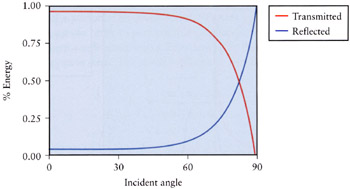
Figure 3.31: The averaged reflectance and transmittance values for the air-glass interface.
We can see that as the incident angle approaches 90°, the reflectivity approaches 100%. This is one of the more important aspects of the Fresnel equations—at a glancing angle, all surfaces become perfect reflectors, regardless of what the surface is made. In fact, this is one way in which x-rays are focused. The only fly in the ointment is that this is true only for perfectly flat surfaces, but this will be covered in the next section.
To be thorough, we should also take a look at the other side of the interface, when looking though a medium of higher refractive index to that of a lower one. In this case, we will reach an incident angle where we reach total internal reflection, and no light will be transmitted through the interface. If we reverse the indices of refraction and take a look at the glass-air interface, we get the plots shown in Figure 3.32.

Figure 3.32: A glass-air interface shows that we reach a point where all light is reflected internally.
At the critical angle of 41.8°, we get total internal reflection, and no light is transmitted through the interface. Thus if you wanted to model something like a scene underwater, you'd need to treat the water surface as a mirror surface at any angles over the critical angle.
The Fresnel Term in Practice
For real materials, the Fresnel term depends upon the incoming angle of light and the reflected angle. The reflected angle is a function of the indices of refraction of both materials, which in turn, are dependant upon light wavelength and density of the materials. The density, in turn, typically is a function of temperature. The index of refraction usually increases with the density of the medium, and usually decreases with increasing temperature. This is all very fine if you happen to have data for the index of refraction for the wavelengths of interest over the temperatures you'll need. Since this kind of data is difficult to find, we'll do what innumerable computer graphics researchers have done before us—we'll fake it.

Figure 3.33: The averaged reflectance and transmittance curves for the glass-air interface.
To get a reasonable estimate on the Fresnel term, Cook and Torrance [COOK 1982] note that the values of reflectance at normal angles of incidence are more commonly found. You can get the Fresnel value at this angle (called F0) and then calculate the angular dependence by back-substituting for the index of refraction using F0 and then plugging this value for the index of refraction back into the original Fresnel equation. This gives you the Fresnel value as a function of the angle of incidence. In order to perform this calculation, we need to reformat the Fresnel equation for reflectance into a form derived by Blinn [BLINN 1977]. This is easier if we do it in steps. The parallel reflectance part of Fresnel's equation is

If we get rid of the tangent using tan2(φ) + 1 = sec2(φ) = 1/cos2(φ), then we can rework the equation into terms that involve only cosines. The new equation is

And then we can use the cos(φ ± θ) = cos(φ) cos(θ) ± (−1) sin(φ) sin(θ) identity to break it down into terms involving θi and φt separately, and use Snell's law as ηλsin(φr) = sin(φi), where ηλ = ηr/ηi.

Blinn introduced the term g in his paper to simplify the equations a bit, and we'll do the same here.
![]()
First multiplying through by ηλ/ηλ and then replacing with g yields

Then we can use the sin2(φ) + cos2(φ) = 1 identity to remove the sine term and replace it with a cosine term, which will allow a further replacement with the g term to further simplify the equation to

Finally, we use the term g2 = η2λ + cos2(φi) − 1 and factor out common terms to get

Whew! What we've now got is an expression for a Fresnel term that is only a function of ηλ and φi. Let's do the same with the perpendicular reflection term.

Using the sin(φ ± θ) = sin(φ) cos(θ) ± cos(φ) sin(θ) identity breaks out the equation into terms involving φi and φt separately.

Then use Snell's law to get rid of the sine terms.

and finally replace the ηλ cos(φr) with g to get

Finally, add the two pieces of the Fresnel reflection terms and average, and we get

Since
![]()
we now have a Fresnel equation that's dependant upon only three values–the two indices of refraction and the incident angle.
Well, that's great, but why have we gone through all that? It's to further simplify the equation. If we look at the equation at normal incidence, when θ = 0, then cos(θ) = 1 and g = ηλ, then most of the equation cancels out, and we're left with

Ok, what's the advantage of this? Well, this lets us assume a value for ηλ when the light is normal to the surface. In other words, when we shine a light directly at the surface and look from the same direction (normal incidence), then this equation lets us solve for ηλ at this angle. Thus we can rearrange the equation to read

You can then use the values of ηλ generated in this way to plug into the equation to generate Fr at other angles.
|
|
EAN: 2147483647
Pages: 104